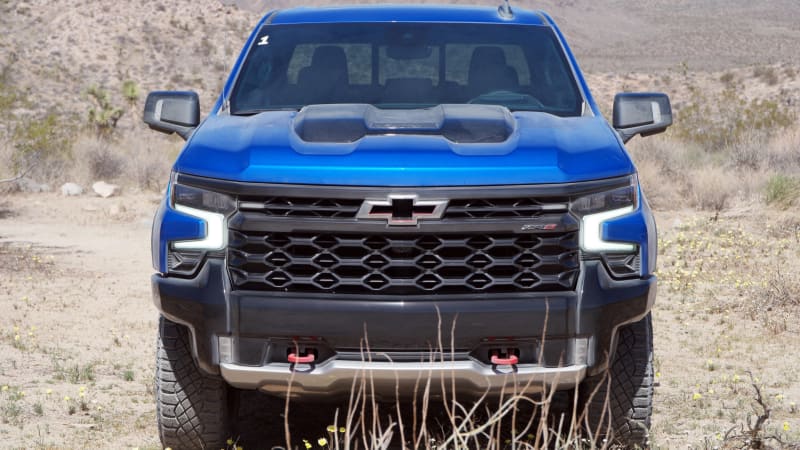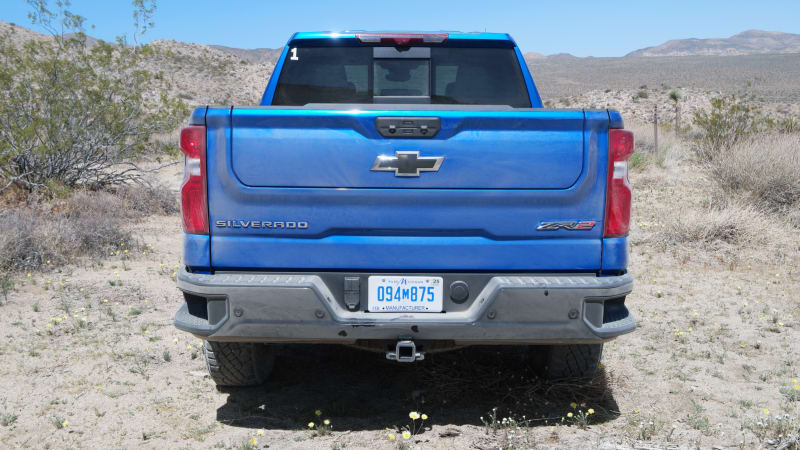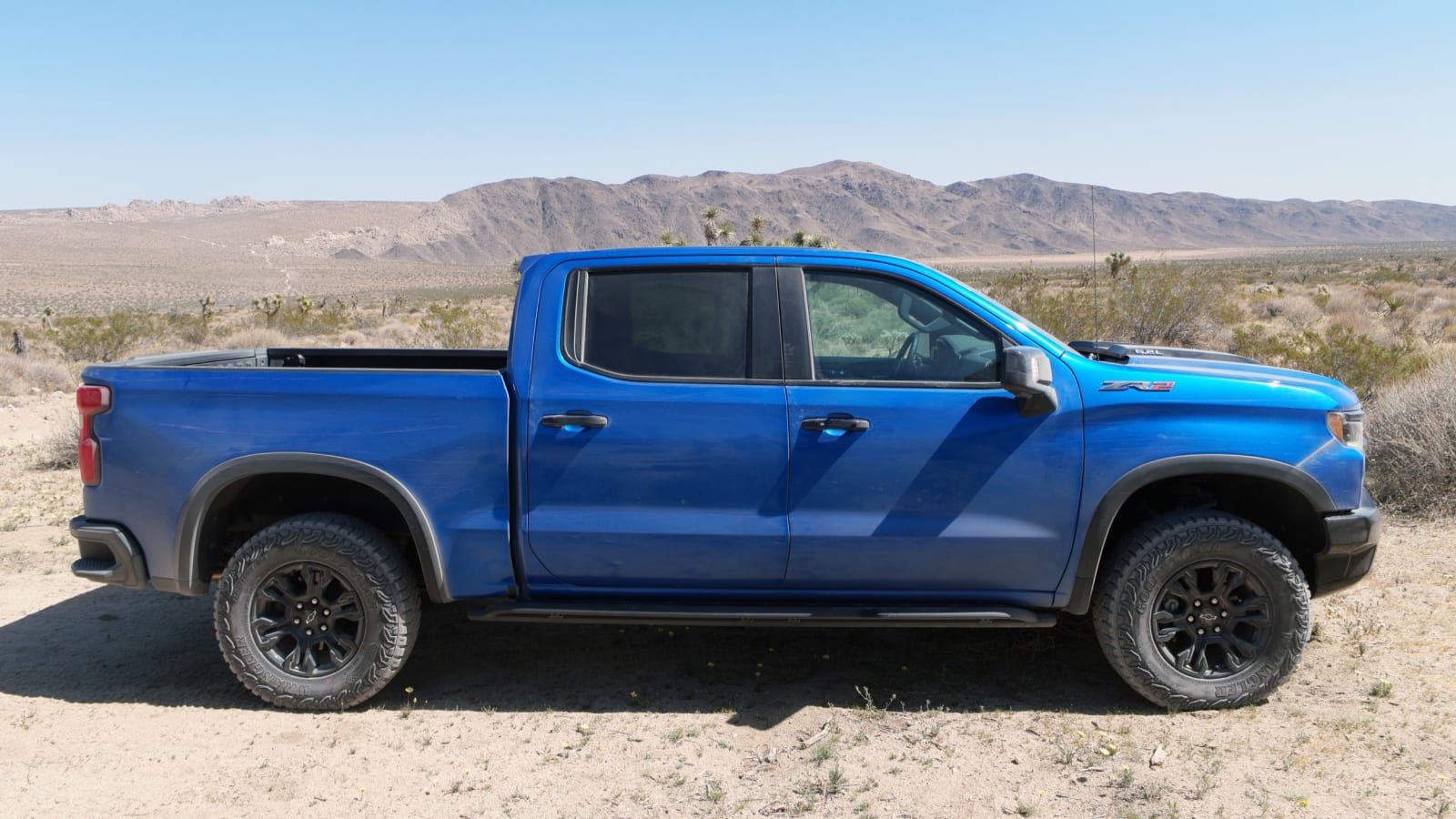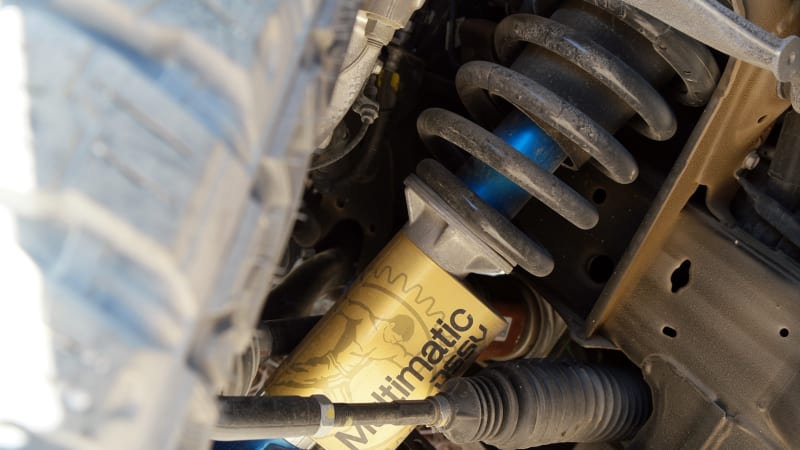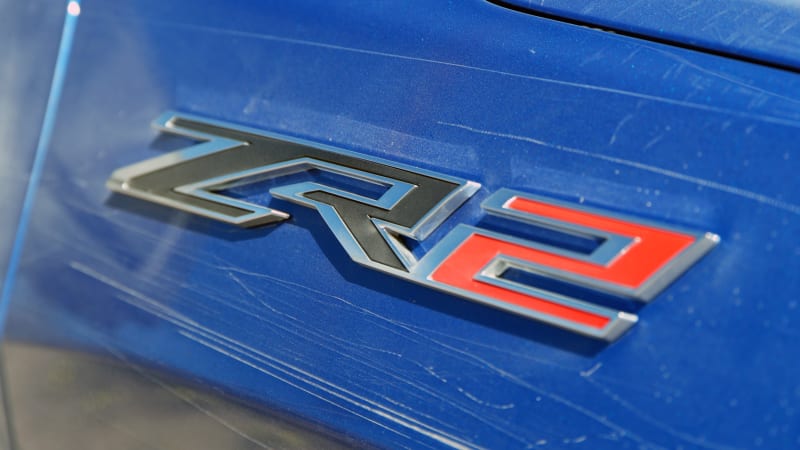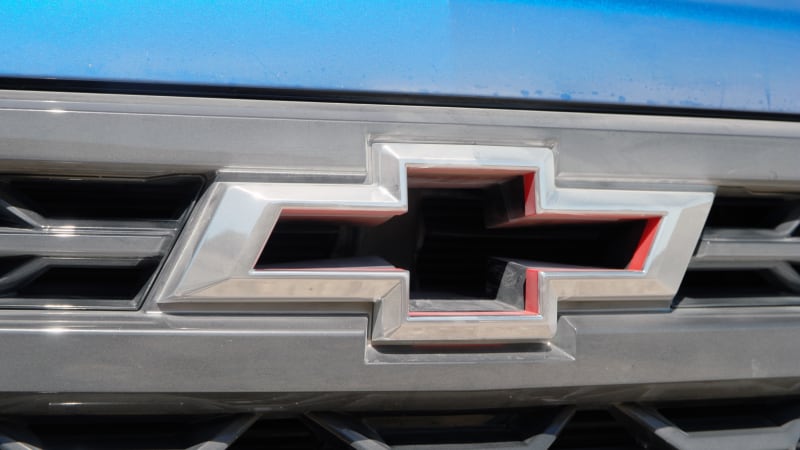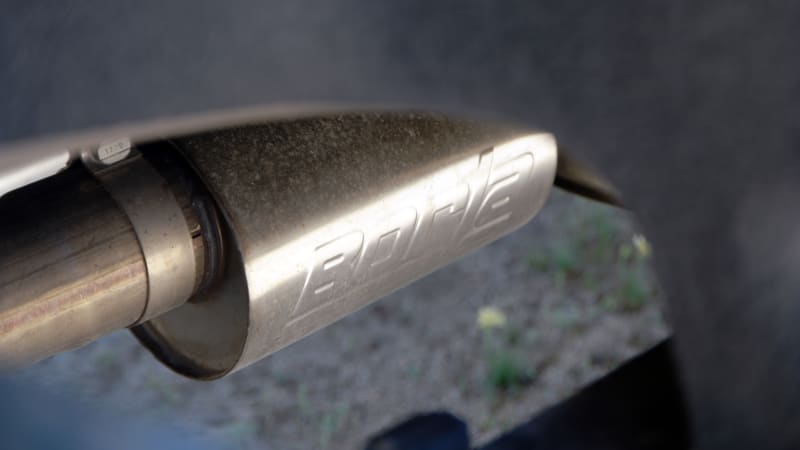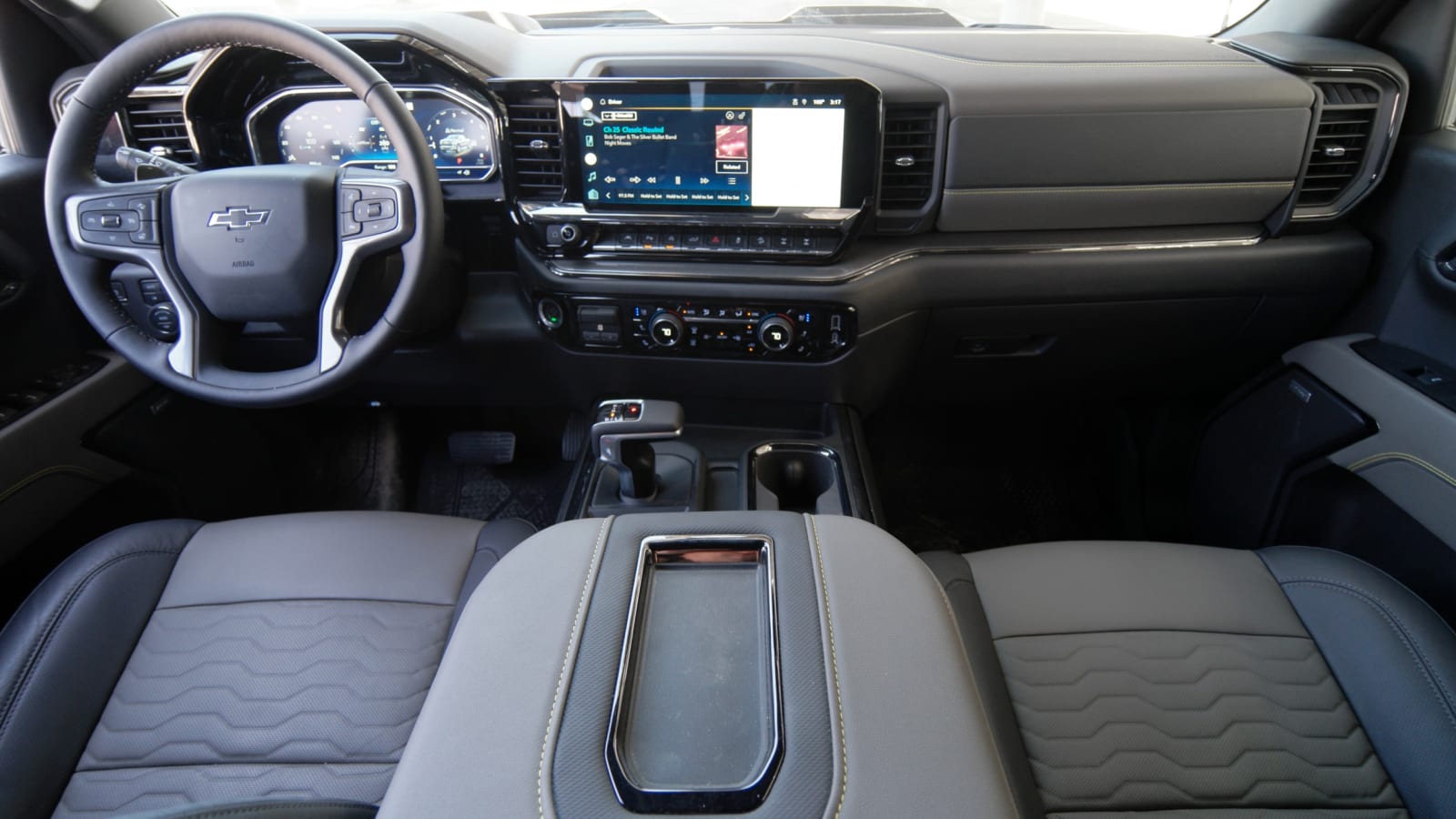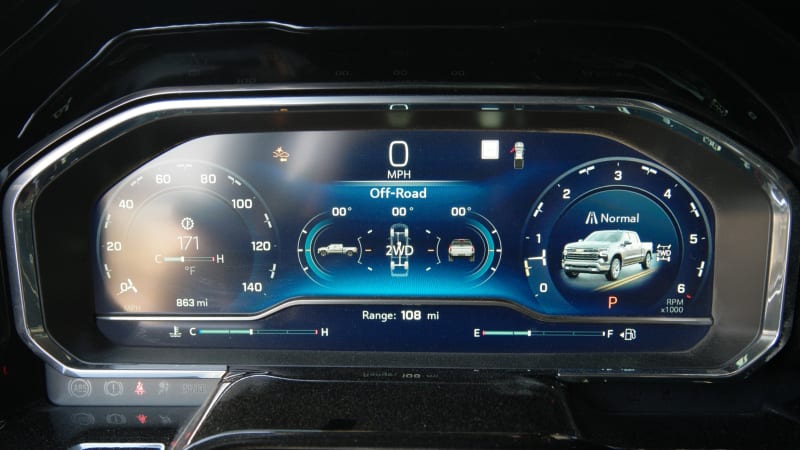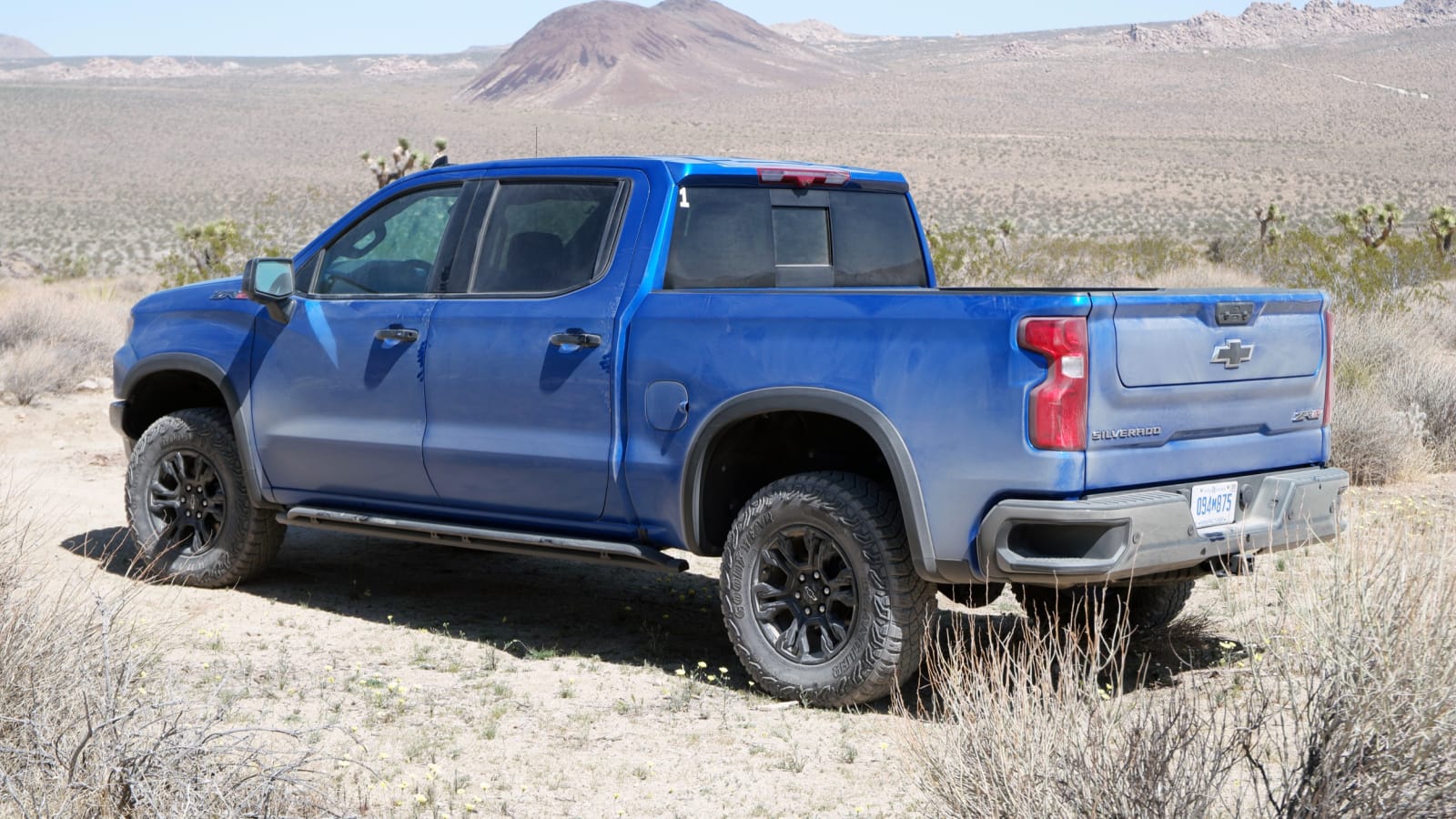Chevy Silverado buyers have had no choice but to look enviously at the high-speed off-road specialist pickup trucks from Ford and Ram ever since the SVT Raptor invented the segment in 2010. That’s a long time to wait for a Bowtie-badged desert runner, and there are few things more important to full-size truck buyers than bragging rights. Enter the 2022 Chevy Silverado ZR2, which adds a set of high-performance shocks, locking front and rear differentials, and greater ground clearance and suspension travel than any other full-size truck in GM’s portfolio.
But is it a real Raptor competitor? The answer is a qualified yes or a qualified no, depending on your point of view. And we think that’s entirely by design. The ZR2 provides greater capability than the Ford F-150 Tremor, Ram 1500 Rebel, Toyota Tundra TRD Pro and Chevy’s own Silverado Trail Boss, but occupies its own place in the segment. Think of it as more of a Raptor alternative, and also consider that GM may have left some room for future off-road editions that could conceivably be in the product pipeline.
First, let’s talk numbers. The Silverado ZR2 boasts an approach angle of 31.8 degrees, a breakover angle of 23.4 degrees, and a departure angle of 23.3 degrees. Those figures are superior to the Trail Boss, and in the ballpark of the Tremor (27.6 degrees, 21.2 degrees and 24.3 degrees) and Raptor (31.0 degrees, 23.9 degrees and 22.7 degrees). Ground clearance measures 11.2 inches, and its suspension travel checks in at 9.84 inches front and 10.62 inches rear. That’s nowhere near the Raptor’s 14 inches of front or 15 inches of rear-wheel travel. Also, the ZR2 hits its figures with 33-inch tires, not the standard 35s of Ford’s Jurassic Truck and certainly not the 37s that are optional.
Those off-road-specific calculations drive headlines, but there are other numbers that are just as important to consider, and some have to do with daily drivability and trail survivability. Put simply, the Raptor is an imposing beast. Notably, it’s about 5 inches wider than the ZR2’s measured width of 81.2 inches (mirrors excluded). Those are a very meaningful handful of inches when navigating tight off-road terrain as well as the average suburban driveway or a city parking garage.
Without a proper side-by-side towing comparison, we can’t compare the overall feeling of putting several tons behind either the ZR2 or the Raptor, but we’d wager the Chevy would inspire more confidence due to its less extreme tires and wheel travel. By the numbers, the ZR2’s 1,440-pound payload rating and 8,900-pound tow rating eke out small victories over its rival from the Blue Oval.
One area where the Raptor absolutely trounces the ZR2 is under the hood. Chevy stuck with its tried-and-true 6.2-liter V8, which sends 420 horsepower and 460 pound-feet of torque to all four wheels through a 10-speed automatic transmission. That’s more than the 400 hp of the F-150 Tremor, but the Raptor comes standard with an upgraded 3.5-liter twin-turbo EcoBoost V6 with 450 hp and 510 lb-ft. Though Chevy hasn’t supplied a final figure, the weight difference won’t be dramatic. In a classic quarter-mile race, the Raptor is very likely to have a sizable edge. And we’re not even going to mention the 702-hp Ram TRX … um, oops, guess we just did.
In the real world where owners won’t be aiming for holeshots at every green light, Chevy’s big-displacement V8 is a strong truck engine. Our test truck was fitted with a Borla-branded performance exhaust system that will be available from Chevy (it should really be standard), exiting through dual pipes tucked up under the rear bumper so they won’t get damaged off pavement. There are few sounds sweeter than the rumbly roar of a classic American V8, and as good as the Raptor’s engine is, it can’t match the Chevy’s burble. Fuel economy estimates sit at 14 mpg in the city, 17 on the highway and 15 combined. That’s 1 mpg behind the Raptor and several behind the Tremor, for those keeping track … and we’d bet that won’t include likely buyers of either of these trucks. What may matter more is that the Raptor’s 26-gallon tank means it can go up to 416 miles per tank compared to the 24-gallon ZR2’s 360-mile range. The Ram TRX scores a truly dismal 12 mpg combined, so it’s a good thing it holds 33 gallons.
The ZR2’s 10-speed automatic transmission works perfectly without any nasty gear-changing hiccups, and it responds quickly with well-timed downshifts when called upon. No complaints there.
The single biggest piece of the Silverado ZR2 puzzle is its quartet of Multimatic Dynamic Suspensions Spool Valve (DSSV) shocks. Similar tech is found in all manner of high-performance machinery, including the Chevy Colorado ZR2 as well as the Chevy Camaro ZL1 1LE and Ferrari SF90 Stradale Assetto Fiorano. Obviously there are differences between the shocks used in differing applications, but they work wonderfully in each and every one of them, including the new Silverado ZR2. GM says these 40-mm DSSV shocks feature three separate spool valves and three connected chambers for fluid flow. You can read a lot more about how they do what they do here.
Without the benefit of back-to-back testing between the Chevy and Ford trucks, we think the ZR2 is sprung more stiffly than the Raptor — probably not surprising given the difference in wheel travel — but the general feeling of control from the off-road Silverado is excellent. Ford uses coil springs at all four corners, but Chevy has stuck with traditional truck-spec leaf springs for the ZR2’s rear (and all other Silverados for that matter). No matter, we never felt any untoward feelings from the back of the truck whether we were bounding over boulders, sliding over sand or even cruising the highway at 75 mph. In the case of the ZR2, it’s the shocks, not the springs that matter most.
Another serious upgrade over lesser Silverados are front and rear electronic locking differentials. This is a point of differentiation from the Raptor, which comes standard with a rear locker and can be optionally equipped with a Torsen limited-slip front unit. In theory, the front locker may be superior in certain low-traction situations. We put it to the test on a gravely incline with side-to-side dips massive enough to lift one tire off the ground at a time. We made it up without drama, and while we think a Raptor would have found enough traction to make the climb, it very well may have taken a lot more wheelspin to do it.
A couple more pieces of tech are worth mentioning. The ZR2 comes with what Chevy calls Terrain Mode, which has settings selectable through a scrolling wheel that includes a one-pedal-driving option. Basically, this means the driver can lock the Silverado ZR2 into 4WD Low, manually select first gear and then use nothing but the throttle pedal to inch forward. Letting off the throttle will slow the truck and even bring it to a stop without touching the brakes. There is also a forward-pointed camera that allows the driver to clearly see what lies ahead, along with offering views to the right, left and behind.
Silverado ZR2 models get unique styling details inside and out. Most noticeable are the unique grille with a hollowed-out Flowtie Bowtie, a non-functional black hood dome and a three-piece steel bumper setup that includes replaceable side pieces with deep contouring to minimize the likelihood that an owner will damage them off road. Chevy’s fancy Multi-Flex Tailgate is optional.
Now that we’ve covered what separates the ZR2 from other Silverado trucks, let’s address the next elephant in the showroom: the interior. The entire Silverado range gets a number of improvements for 2022 that apply just as much to the ZR2 as the luxurious High Country, chief among them the dashboard and infotainment systems.
We’ll cut right to the chase. The Silverado’s new interior is a drastic improvement over the previous truck (the old interior is still standard on the Work Truck, Custom and Custom Trail Boss), looking and feeling fully competitive with its rivals from Ford, Ram and Toyota. Which interior is best-in-class is debatable, but suffice it to say that GM is now officially in the game. There is a strong horizontal theme to the new interior, highlighted by a nice row of buttons in between the touchscreen above and easy-to-use climate controls below. There’s a stubby electronic gearshift selector on the console, replacing the previous obligatory column shifter, plus a wireless phone charging cradle and a big pair of cupholders.
The ZR2 features a unique version of the new Silverado interior with black and grey leather seating surfaces and shiny black chrome trim pieces that are worlds better than standard piano black plastic. A 13.4-inch touchscreen runs software based on Google’s Android Automotive package. Google’s Maps, Assistant and Play Store are all neatly integrated, and both Android Auto and Apple CarPlay are fully supported. We had surprisingly good success rates while using the integral voice recognition — “Hey Google, find me a covered parking spot” returned several nearby results that we could map to with a single touch.
The 2022 Chevy Silverado ZR2 starts at $69,205 including its $1,695 destination charge. That’s just barely under the $70,470 it takes to drive home in a Raptor with zero options. We have a hard time considering either of these trucks “bargains,” but considering the overall packages, we’d have thought Chevy would have more aggressively undercut Ford’s asking price.
So, back to the question at hand. Is the Chevy Silverado ZR2 a Ford Raptor competitor? Yes, in that it offers Bowtie buyers a legitimate high-end off-road package with a specifications that allow it to traverse some seriously tough terrain. We’re especially fond of its high-tech DSSV shocks. But also no, in that the ZR2 doesn’t offer any powertrain or widebody exterior upgrades to fully match up with Ford’s offerings. It also doesn’t come close to the performance capabilities of the $78,675 Ram TRX, though to be fair nothing else does, either.
Really, the ZR2 sits in a unique spot in the truck market. It’ll do all the off-roady stuff — its standard locking differentials may be an important differentiator for some buyers — and it will also play (comparatively) nice with real-life pickup duties. It ought to fit into a lot more garages and parking spots than a Raptor, too. Perhaps most importantly, Chevy is now properly in the off-road-truck conversation, which is sure to be enough for a number of diehard Bowtie fans.
Source: www.autoblog.com

